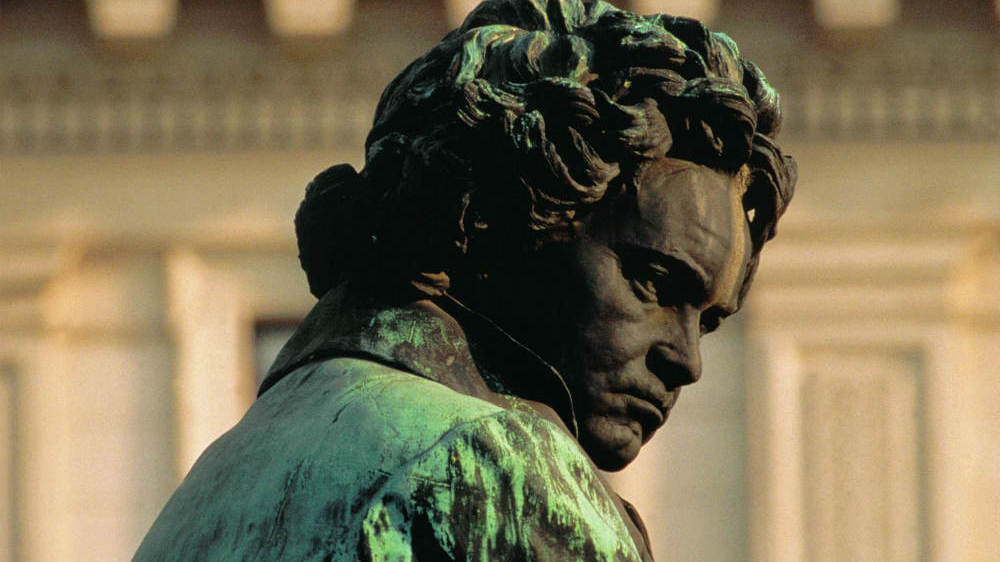Beethoven’s Fifth Piano Concerto begins with a bold and unexpected announcement. Four chords in the orchestra, outlining the most elemental harmonic progression (I-IV-V-I), stand as mighty pillars. Each initiates an expansive cadenza from the solo piano. A cadenza at the beginning of a concerto? This is not what the first audiences would have been expecting. These first bars establish the piano as a heroic, convention-defying protagonist. The orchestra launches into the expected introduction only after the piano has had its say. Fiery and euphoric, this introduction is filled with the spirited dotted rhythms of French Revolution era military marches. We know that we are off on an exhilarating adventure.
This was Beethoven’s final and most monumental piano concerto, written between 1809 and 1811 as Napoleon’s army bombarded the city of Vienna. “What a disturbing, wild life around me; nothing but drums, cannons, human misery of every sort,” wrote Beethoven to his Leipzig publisher Gottfried Christoph Härtel on July 26, 1809. The work is set in E-flat major, the same blazing, heroic key as the Eroica Symphony. Unlike the Third Symphony, Beethoven did not provide the subtitle, “Emperor,” which was added by the English publisher, Johann Baptist Cramer.
As you listen to the first movement, notice the way the music alternates abruptly between sharply contrasting worlds. At moments (as in the second theme) we enter a place of dreamy serenity. Yet we’re always pulled back into the fanfares and drums of revolution. One of the most striking examples of this comes at the end of the development section where the opening theme’s ornamental turn takes on a life of its own, repeating with increasing persistence and eventually thrusting us back into the recapitulation. Beethoven’s music is filled with these small, seemingly insignificant passing lines which take on heroic dimensions.
In classical concertos, it was customary for the soloist to improvise a cadenza at the end of the first movement. Here, Beethoven shatters convention, again. He sets up this moment with incredible drama, but then writes in the score: Non si fa una Cadenza, ma s’attacca subito il seguente (“There is no cadenza; instead, proceed directly with the following”). What is provided is the beginning of a written out cadenza—perhaps you could call it a “false” cadenza—which quickly transitions into a conversation with the horns.
The second movement (Adagio un poco mosso) moves to the distant harmonic world of B major, a key briefly introduced in the first movement’s second theme. It’s a serene and sensuous nocturne, enveloped in the dark veil of muted strings, and developing out of an achingly beautiful and lamenting melody. First introduced by the orchestra, this melody returns in the solo piano, surrounded by embellishment and conversing with the woodwind voices.
Time seems to stop as the second movement fades into a mysterious bridge to the final movement. Amid breathless anticipation, the piano quietly gives us a teasing taste of the new theme. Then suddenly, we launch into a joyful and exuberant seven-part rondo which ventures into a variety of distant keys and motivic adventures. Notice the way this motivic cell returns in the spirited final moments. In its final bars, this monumental and heroic concerto winds down with a duet between the piano and timpani.
Perhaps as a result of his advancing hearing loss, Beethoven did not perform this concerto. A private performance took place on January 13, 1811 at the Palace of Prince Joseph Lobkowitz with Beethoven’s student and patron Archduke Rudolf performing as soloist. A year later, Carl Czerny gave the public premiere in Vienna. Here is Krystian Zimerman’s 1989 live performance with Leonard Bernstein and the Vienna Philharmonic:
Five Great Recordings
- Beethoven: Piano Concerto No. 5 in E-flat Major, Op. 73, Krystian Zimerman, Leonard Bernstein, Vienna Philharmonic Amazon
- Daniel Barenboim with Mariss Jansons and the Bavarian Radio Symphony Orchestra (2017 live performance)
- Hélène Grimaud with Wladimir Jurowski and the Staatskapelle Dresden (2007 recording)
- Murray Perahia with Bernard Haitink and the Concertgebouw Orchestra (1986 recording)
- Arthur Rubinstein with Eugene Ormandy and the Philharmonia Orchestra (1963 live recording)

